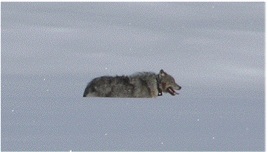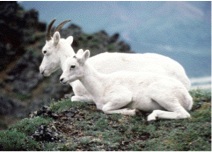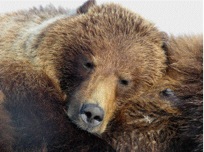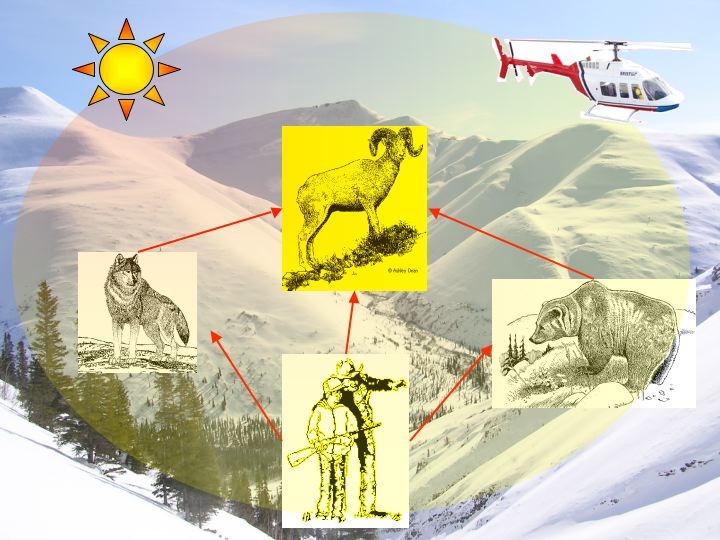


Socio-ecological Context
The
Richardson Mountains, located at the Northwest Territories
and Yukon border, are an area of high traditional use by
the Gwich’in and Inuvialuit People. A number of Gwich’in
archeological sites exist along the main drainages, and
various routes and family trails have been established
generations ago to travel between hunting and meeting areas
(Haszard and Shaw 2000). Nowadays, the Richardson Mountains
are still widely used by the Gwich’in from Fort McPherson
and Aklavik, the Vuntut Gwitchin from Old Crow, and the
Inuvialuit from Aklavik, and are considered a prime area
for hunting large mammals such as caribou
(Rangifer
tarandus), moose
(Alces
alces),
Dall’s sheep (Divii in Gwich’in, Ovis
dalli dalli), and
grizzly bears (Shih, Ursus
arctos). The
Richardson Mountains fulfill the subsistence and
recreational needs of many northern peoples. Moreover,
local communities have recently expressed an interest for
developing an outfitting venture in these mountains.
Although the area is presently relatively pristine,
forthcoming oil and gas development in the adjacent
Mackenzie Valley may leave a heavy footprint. Indeed, if
the Mackenzie Gas Project goes ahead, the Richardson
Mountains are predicted to be developed within the next 30
years (Holroyd and Retzer 2005). Exploration surveys have
already started in summer 2006 (Devon Canada’s geological
field trip), and more is to be expected next year.
Additionally, the Arctic is among the most impacted biomes
by climate change (ACIA 2005, Walther et al. 2002). A rapid
warming will likely influence abundance and composition of
vegetation, wildlife, and parasite species. The Richardson
Mountains are therefore likely to undergo significant
changes in the future, and there is a need to assess the
current species’ status and interactions in order to
monitor future changes and ensure sustainable management of
land and wildlife in this region.
Dall’s sheep in the Richardson Mountains are a relatively
small and isolated population at the northeastern limit of
the species range (Valdez and Krausman 1999), and seem to
be declining since the mid 1990s. The latest census counted
700 individuals (2006 GNWT, YTG & GRRB survey, unp.
results), about half the estimated 1997 population.
Furthermore, the 2003 survey reported low recruitment
rates, as evidenced by a low lamb:ewe ratio, low lamb
survival, and an old age structure (J. Nagy, GNWT, personal
comm.). Prior research by Barichello et al. (1987) and the
Gwich’in Renewable Resource Board (GRRB; Auriat 2005)
identified the range, movements and habitat use of this
population, and provided disease and physiological
information. These radio-tracking studies were however
focused on rams, and little information is available on
ewes. Because ewes play an essential role in population
recruitment, there is a need to learn more about this class
of the population. Harsh climatic conditions and
overgrazing have been identified as limiting factors, but
the impact of predation has received little attention so
far. Wolves and grizzly bears are common predators in the
mountains, although very little is known about their actual
demographic parameters (abundance, composition), habitat
use, nutritional ecology, and impact on this sheep
population. Local and traditional knowledge have reported
observations of both grizzly bears and wolves preying on
sheep (Shaw et al. 2005).
Grizzly bears are a species of Special Concern in the
Northwest Territories (COSEWIC 2002). They have large home
ranges and slow life history traits, which make them
vulnerable to the loss of few individuals. Upcoming oil and
gas development in our region may increase their
vulnerability and mortality rate (Edwards et al. 2005). On
the other hand, research in Alaska identified grizzly bears
as the main predator of caribou calves (Adams et al. 1995),
and their role as a potential ungulate predator seems to be
more important during the first few weeks of life (see
Zager and Beecham 2006 for a review). We suspect that they
may also be a limiting factor for Dall’s sheep,
particularly for the lamb segment of our study population.
At present, the productivity of grizzly bear females in the
Richardson Mountains was studied from 1992 to 2000
(Branigan 2000). However, critical habitat and habitat use
patterns still need to be identified, and grizzly bear
predation patterns and nutritional ecology also need to be
investigated. This information is essential not only to
understand the influence grizzly bears may have on Dall’s
sheep, but also to update and expand important baseline
information on bears in the Richardson Mountains.
According to recent community consultations, wolves
(Zhoh, Canis
lupus) are
believed to be stable to increasing in the Richardson
Mountains. Wolves can significantly limit mountain sheep
populations (Sawyer and Lindzey 2002), and research in
Kluane and Denali National Parks have demonstrated that
they represent a major mortality factor for Dall’s sheep
(Mech et al. 1985, Murie 1944, Sumanik 1987). Arctic wolf
populations also rely on other ungulates, such as caribou
and moose, and some packs tend to follow barren-ground
caribou herds in their migratory paths (Walton et al.
2001). In the northern Richardson Mountains and on the
Yukon North Slope, wolves seem to depend mostly on moose
and, seasonally, on the Porcupine Caribou herd (Hayes and
Russell 1998, Hayes et al. 1997, Hayes et al. 2000). Recent
range-wide decline of barren-ground caribou in the
Northwest Territories (DENR 2006) has lead to question the
impact of wolves on caribou, and also to wonder if
alternate prey such has Dall’s sheep will suffer from
higher predation rates as a consequence to lower caribou
availability (i.e. prey switching, Dale et al. 1994).
Additionally, wolf packs surrounding the Dall’s sheep range
area benefit from year-round prey sources, such as the
sheep, moose, and smaller mammals, and may be resident of
the area. Depending on the wolves’ movement pattern and
spatial dynamics, encounter rates and predatory pressure on
Dall’s sheep could vary substantially. Understanding the
wolves’ spatial and predation patterns will help in
assessing their impact on Dall’s sheep and other ungulate
species of the Richardson Mountains.
Objectives
This
project was designed to update and expand our ecological
knowledge about the dynamics and interactions between
Dall’s sheep, grizzly bears, and wolves at the spatial
level. There is clearly a need to understand the
spatial ecology of those
species, their
interactions, and
the
factors driving their interactions. I am
particularly interested in:
1. Describing home ranges and movement of Dall’s sheep,
grizzly bears and wolves, to increase the available
baseline information on those populations;
2. Characterizing the level of static and dynamic
interactions between the three species;
3. Understand how the habitat use and interactions between
the three species (movements and predation rates) may be
affected by habitat features such as vegetation, elevation,
slope, and aspect.
...I invite you to click on other sections to discover how
the data was collected and what results are emerging so
far. I conclude this section by a diagram summarizing the
complex interactions affecting this system, including:
Dall's sheep predation by wolves and grizzly bears, human
harvest of the three species, climate warming, and
sensorial disturbances from development and research
activities (helicopter). Other wildlife species, disease
and range condition were omitted from this figure because
of my limited design capabilities!




